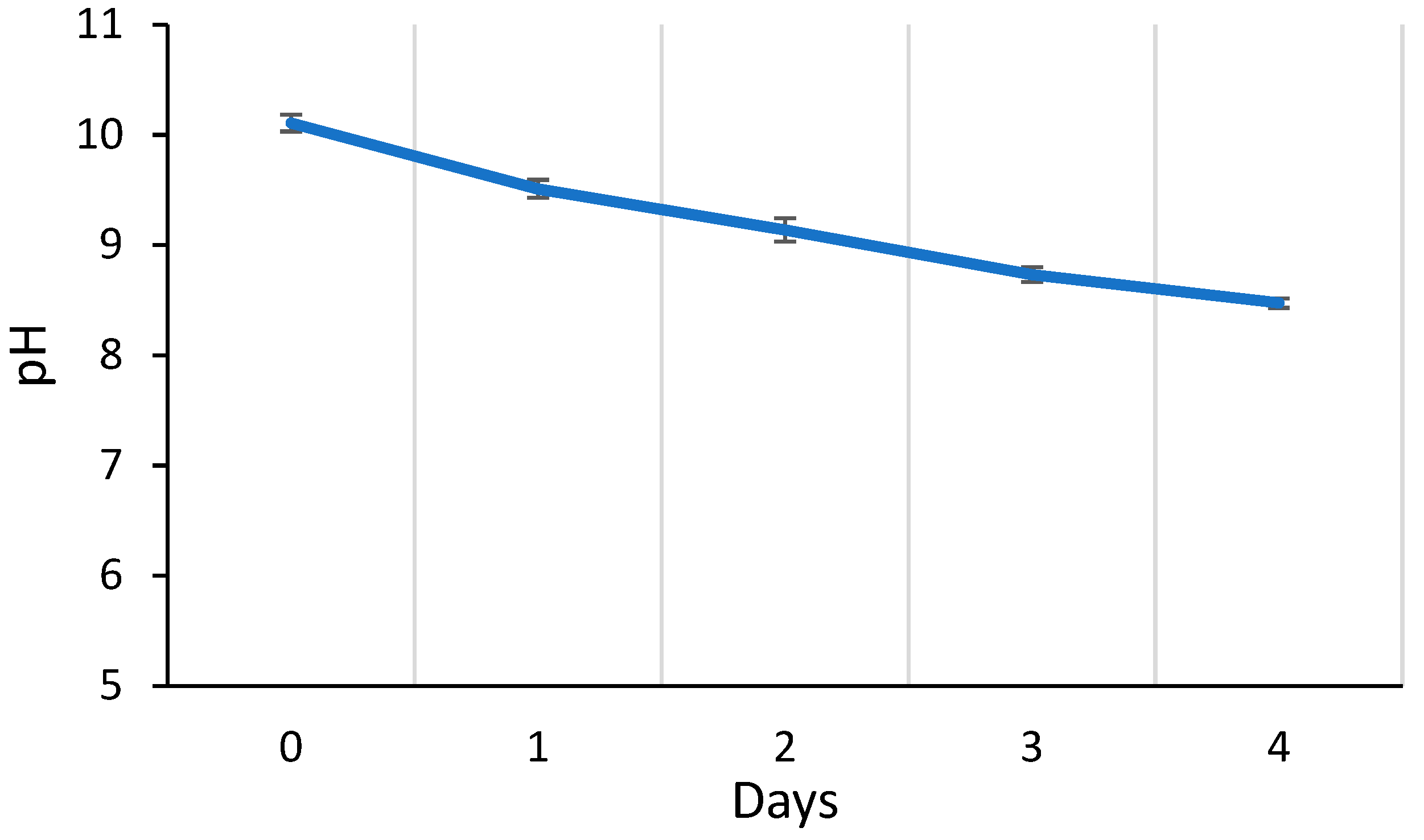Study of Magnesium Hydroxide Protective Coating against Corrosion, Applied on Poly(methyl methacrylate) Plates, By Using the Sulfuric Acid Attack Acceleration Test †
Abstract
:1. Introduction
2. Materials and Methods
2.1. Surface Coating
2.2. Sulfuric Acid Spraying Test
2.2.1. Surface pH Measurements
2.2.2. Mass Measurements
2.2.3. XRD Analysis
3. Results
3.1. Characteristics of Magnesium Hydroxide Powder
3.2. Accelerated Acid Spraying Test
3.2.1. Surface pH Results
3.2.2. Mass Change Results
3.2.3. XRD Analysis
4. Conclusions
Author Contributions
Funding
Institutional Review Board Statement
Informed Consent Statement
Data Availability Statement
Acknowledgments
Conflicts of Interest
References
- Sydney, R.; Esfandi, E.; Surapaneni, S. Control Concrete Sewer Corrosion via the Crown Spray Process. Water Environ. Res. 1996, 68, 338–347. [Google Scholar] [CrossRef]
- Wang, T.; Wu, K.; Kan, L.; Wu, M. Current understanding on microbiologically induced corrosion of concrete in sewer structures: A review of the evaluation methods and mitigation measures. Constr. Build. Mater. 2020, 247, 118539. [Google Scholar] [CrossRef]
- Talaiekhozani, A.; Bagheri, M.; Goli, A.; Reza, M.; Khoozani, T. An overview of principles of odor production, emission, and control methods in wastewater collection and treatment systems. J. Environ. Manag. 2016, 170, 186–206. [Google Scholar] [CrossRef] [PubMed]
- ASCE (American Society of Civil Engineers), WPCF (Water Pollution Control Federation). Gravity Sanitary Sewer Design and Construction; American Society of Civil Engineers: Reston, VA, USA, 2007. [Google Scholar] [CrossRef]
- Hvitved-Jacobsen, T.; Vollertsen, J.; Nielsen, A.H. Sewer Processes: Microbial and Chemical Process Engineering of Sewer Networks; CRC Press: Boca Raton, FL, USA, 2013. [Google Scholar]
- Wells, T.; Melchers, R.E. Findings of a 4 year study of concrete sewer pipe corrosion. In Annual Conference of the Australasian Corrosion Association; Australasian Corrosion Association: Preston, Victoria, Australia, 2014. [Google Scholar]
- Islander, R.L.; Devinny, J.S.; Mansfeld, F.; Postyn, A.; Shih, H. Microbial Ecology of Crown Corrosion in Sewers. J. Environ. Eng. 1991, 117, 751–770. [Google Scholar] [CrossRef]
- Mori, T.; Nonaka, T.; Tazaki, K.; Koga, M.; Hikosaka, Y.; Noda, S. Interactions of nutrients, moisture and pH on microbial corrosion of concrete sewer pipes. Water Res. 1992, 26, 29–37. [Google Scholar] [CrossRef]
- Wu, M.; Wang, T.; Wu, K.; Kan, L. Microbiologically induced corrosion of concrete in sewer structures: A review of the mechanisms and phenomena. Constr. Build. Mater. 2020, 239, 117813. [Google Scholar] [CrossRef]
- Roghanian, N.; Banthia, N. Development of a sustainable coating and repair material to prevent bio-corrosion in concrete sewer and waste-water pipes. Cem. Concr. Compos. 2019, 100, 99–107. [Google Scholar] [CrossRef]
- Aguiar, J.B.; Camões, A.; Moreira, P.M. Coatings for Concrete Protection against Aggressive Environments. J. Adv. Concr. Technol. 2008, 6, 243–250. [Google Scholar] [CrossRef] [Green Version]
- Berndt, M.L. Evaluation of coatings, mortars and mix design for protection of concrete against sulphur oxidising bacteria. Constr. Build. Mater. 2011, 25, 3893–3902. [Google Scholar] [CrossRef]
- James, J. Controlling sewer crown corrosion using the crown spray process with magnesium hydroxide. Proc. Water Environ. Fed. 2003, 2003, 259–268. [Google Scholar] [CrossRef]
- Merachtsaki, D.; Fytianos, G.; Papastergiadis, E.; Samaras, P.; Yiannoulakis, H.; Zouboulis, A. Properties and Performance of Novel Mg(OH)2-Based Coatings for Corrosion Mitigation in Concrete Sewer Pipes. Materials 2020, 13, 5291. [Google Scholar] [CrossRef] [PubMed]
- Merachtsaki, D.; Tsardaka, E.-C.; Anastasiou, E.K.; Yiannoulakis, H.; Zouboulis, A. Comparison of Different Magnesium Hydroxide Coatings Applied on Concrete Substrates (Sewer Pipes) for Protection against Bio-Corrosion. Water 2021, 13, 1227. [Google Scholar] [CrossRef]
- Diamanti, M.V.; Brenna, A.; Bolzoni, F.; Berra, M.; Pastore, T.; Ormellese, M. Effect of polymer modified cementitious coatings on water and chloride permeability in concrete. Constr. Build. Mater. 2013, 49, 720–728. [Google Scholar] [CrossRef]
- Merachtsaki, D.; Tsardaka, E.-C.; Tsampali, E.; Simeonidis, K.; Anastasiou, E.; Yiannoulakis, H.; Zouboulis, A. Study of Corrosion Protection of Concrete in Sewage Systems with Magnesium Hydroxide Coatings. Environ. Sci. Proc. 2020, 2, 27. [Google Scholar] [CrossRef]
- Merachtsaki, D.; Tsardaka, E.-C.; Anastasiou, E.; Zouboulis, A. Evaluation of the Protection Ability of a Magnesium Hydroxide Coating against the Bio-Corrosion of Concrete Sewer Pipes, by Using Short and Long Duration Accelerated Acid Spraying Tests. Materials 2021, 14, 4897. [Google Scholar] [CrossRef] [PubMed]



| Material | SSA (m2/g) | PSD | |
|---|---|---|---|
| d50 (μm) | d90 (μm) | ||
| MHP | 7.0 | 3.8 | 13.1 |
| Material | MgO | SiO2 | CaO | Fe2O3 | Al2O3 | SO3 | LOI |
|---|---|---|---|---|---|---|---|
| MHP | 62.81 | 4.25 | 2.46 | 0.25 | 0.10 | 0.02 | 30.11 |
| Day 1 | Day 2 | Day 3 | Day 4 | |
|---|---|---|---|---|
| Mass change (%) | −3.9 | −6.6 | −15.7 | −24.6 |
Publisher’s Note: MDPI stays neutral with regard to jurisdictional claims in published maps and institutional affiliations. |
© 2021 by the authors. Licensee MDPI, Basel, Switzerland. This article is an open access article distributed under the terms and conditions of the Creative Commons Attribution (CC BY) license (https://creativecommons.org/licenses/by/4.0/).
Share and Cite
Merachtsaki, D.; Tsardaka, E.-C.; Anastasiou, E.; Zouboulis, A. Study of Magnesium Hydroxide Protective Coating against Corrosion, Applied on Poly(methyl methacrylate) Plates, By Using the Sulfuric Acid Attack Acceleration Test. Mater. Proc. 2021, 5, 4. https://doi.org/10.3390/materproc2021005004
Merachtsaki D, Tsardaka E-C, Anastasiou E, Zouboulis A. Study of Magnesium Hydroxide Protective Coating against Corrosion, Applied on Poly(methyl methacrylate) Plates, By Using the Sulfuric Acid Attack Acceleration Test. Materials Proceedings. 2021; 5(1):4. https://doi.org/10.3390/materproc2021005004
Chicago/Turabian StyleMerachtsaki, Domna, Eirini-Chrysanthi Tsardaka, Eleftherios Anastasiou, and Anastasios Zouboulis. 2021. "Study of Magnesium Hydroxide Protective Coating against Corrosion, Applied on Poly(methyl methacrylate) Plates, By Using the Sulfuric Acid Attack Acceleration Test" Materials Proceedings 5, no. 1: 4. https://doi.org/10.3390/materproc2021005004









